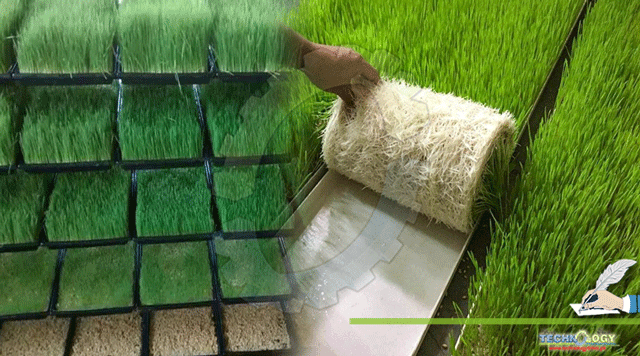Hydroponic is a method of growing plants without the use of soil. A well-balanced nutrient solution dissolved in water meets all the plant’s nutritional and developmental needs. It is often referred to as “soilless plant cultivation.”

HYDROPONIC GREEN FODDER:
Green fodder is an essential component of dairy animal nutrition because it provides necessary nutrients for milk production and animal health. Because high-quality green fodder is scarce throughout the year, milk producers must supplement their feed with additional concentrates to maximize milk output. Shortage of irrigated pasture land for fodder production, high labor expenses and tiny landholdings have presented several challenges to dairy farmers.
As arable land and natural resources continue to diminish in response to climate change, sustainable technologies will be essential for the dairy industry’s long-term viability. Grow-in-place technology is the science of growing plants in nutrient-rich fluids rather than soil, and it can be used to reduce land pressure for livestock feed production.
Plant growth necessitates include the presence of water, nutrients, and sunlight. Hydroponics is a straight forward method of providing all these nutrients without using soil in a controlled environment to maximize plant development. This method has been tested on a variety of crops, including maize, sorghum, barley and oats, with the goal of producing high-quality green feed for dairy cattle. Additionally, hydroponics may be used to grow wheat grass, paddy seedlings, and other plants in as little as seven days. A grain of grass is generated hydroponically; it also has roots, stems and leaves, whereas a stalk of grass is traditionally created.
HYDROPONICS ARE REQUIRED:
Hydroponics is essential to solve the following challenges:
1) The tiny landholdings of dairy producers.
2) There is a scarcity of fodder-producing land.
3) There are limited resources for irrigation, fencing, and land preparation.
4) Increased labor costs in the agricultural industry.
5) The scarcity of educated unemployed young people in the fodder growing industry.
6) The demand for green fodder vastly exceeds the supply.
THE BENEFITS OF HYRDOPONICS:
- Water conservation: Instead of 60-80 liters of water to produce one kilogram of lush green feed, only 2-3 liters of water are required. Its conventional fodder production technology uses hydroponic waste-water to grow fodder, which is environmentally friendly.
- Land measuring 10 m x 4.5 m can produce 600 kg of green feed per day per unit, whereas one hectare of land can produce a classic green grass field. Reducing the amount of land needed to produce the maximum feed can be a challenge in difficult-to-farm and densely populated areas.
- Compared to conventional fodder production, hydroponics only requires 2-3 hours of labor every day. This is significant time-saving.
- Green fodder grows at a faster rate: It takes a little over seven days from seed germination to a fully established plant of 25-30 cm in height, compared to the previous 07 days. The biomass conversion ratio is 7-8 times greater than conventional 60-80 day feed.
- Green fodder throughout the year: Technology has the potential to generate green fodder throughout the year.
- Supply may be coordinated regardless of the weather conditions.
- Increasing the nutritional value of fodder: Increasing the nutritional content of fodder for dairy cows by adding growth boosters, minerals, and other additives.
- The creation of hydroponic green fodder is 100 percent natural, and it is used as animal feed. The development of green fodder does not include the use of pesticides that could contaminate dairy products.
- It is possible to reduce the expense of concentrate feed by increasing milk production by providing green grass to milch animals. Keeping fodder loss to a bare minimum: Unlike chopped traditional grasses, green fodder created by hydroponics does not lose its nutritional value when fed.
CONCLUSION:
Hydroponics is an innovative approach for growing food that is of great nutritional value. Reduced milk feeding costs can be achieved using natural green feed. With land becoming scarce and costs increasing, reduced fodder production could result in more area being used for other crops, so improving the economy and long-term sustainability of the land. This strategy also helps to reduce the strain on the irrigation system, which is already overburdened. Using hydroponics to grow green fodder allows for more climatic control and a more consistent daily production. Dairy farmers in places with limited land holdings, insufficient water, saline water, expensive labor and land prices are currently pursuing this option. A realistic solution to the country’s fodder shortage has been demonstrated using hydroponics technology in green fodder production.
About Authors:
Dr. Rizwan Maqbool
Assistant professor, Department of Agronomy, UAF
Burhan Khalid
Department of Agronomy, UAF
Assistant Professor, Department of Agronomy, UAF
Bilal Ahmad Khan
College of Agriculture, UOS
College of Agriculture, UOS
Prof. Dr. Muhammad Ather Nadeem
College of Agriculture, UOS